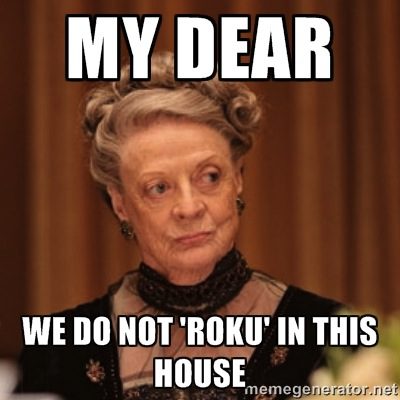TV Is for Old People

I had to wait till last night to watch the Season Five opener of Downton Abbey, which is, alas, turning into a High Tory version of The Waltons. Why the wait? Because we haven’t had broadcast or satellite TV since we moved last summer. All our TV comes to us over the Internet, via the Apple TV box. We’re not big sports watchers, so we don’t miss athletics, and Downton Abbey is the only appointment TV viewing we have. It’s available on the PBS website via streaming the day after broadcast. Sometimes I miss having news on demand, but when I go to my mom and dad’s place and watch about ten minutes of cable news, I realize that things are just fine as they are at my joint. It’s kind of fun to watch the network broadcasts, but in a novelty way. The overwhelming presence of commercials on broadcast and cable TV is jarring. We get all our news from NPR and newspapers on the web.
We abandoned the Dish Network because it was expensive and 99 percent crap. Maybe 99.5 percent crap. When our kids watch TV now, they’re all into old shows that they don’t realize are unspeakably uncool. In fact, the two popular shows with my little ones are Green Acres (“Dad, it’s just like you and Aunt Ruthie, but in reverse”) and The Waltons (which, joking aside, was some quality TV right there).
The Washington Post today writes that TV is becoming entertainment for old people. Excerpt:
Studies show nearly one in four millennials has either cut the cord to cable or never had it in the first place. Of all “cord nevers,” as media analysts call them, nearly 30 percent are between the ages of 18 and 34. Millennials watch around 44 percent of their television on the Internet. Already, 10 million American homes have Internet access, but not cable.
A generational divide over the very meaning of “television” has emerged. For high school students, it may mean YouTube. For millennials: Netflix. For mom and dad: perhaps the networks, the Weather Channel and maybe PBS.
On Monday, some big cable names moved to meet this generational schism. In a partnership with Dish, 12 major cable stations including the Food Network, CNN and, crucially, ESPN, will now stream their programs on a $20-per-month service called Sling TV. This is big news for many rabid sports fans who pay as much as $90 per month for a bunch of cable stations when all they really want is ESPN. They will now be able to watch sports on anything from an iPad to a smartphone — without paying cable companies such as Comcast and Verizon FIOS for television service.
The Post’s Cecilia Kang in her report called the highly-lucrative ESPN a “linchpin” that has long held the cable empire together. In the past several years, many believed the future of cable as we know it today rested on ESPN. “I’ve said this before, but I’d be willing to bet that the momentthat major professional American sports leaps heavily into any kind of reliable, consistent streaming option, that that’s going to be the end of cable subscribers at the levels of the modern era,” wrote Techdirt reporter Timothy Geigner.
That moment has now arrived. Where the industry goes from here is unclear, but many analysts say it portends a new era of television focused on emerging consumers. “Sling TV provides a viable alternative for live television to the millennial audience,” Dish chief executive Joseph Clayton said Monday in a speech.
In our house, we do buy some things a la carte from iTunes, which can be annoying ($1.99 per episode). But it lets us sample a show we might be interested in without breaking the bank, and we end up spending far, far less money that way than we would with a satellite TV or cable subscription.
I doubt we will ever have satellite, broadcast, or cable TV again. Why would we? Wonder what my kids will grow up thinking TV is like? The era in which my musical tastes were formed would be incomprehensible to them. My teenager is used to going on Spotify browsing for stuff that interests him. Last year, he was into Big Band, Sinatra, and Daft Punk. When I was his age, what was on pop radio was what you got, though there was this new thing called “college radio” that was just starting to break…
UPDATE: Now this here is some tee-vee, Chester:
Subscribe for as little as $5/mo to start commenting on Rod’s blog.